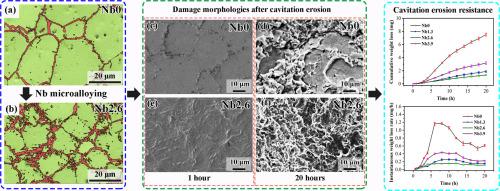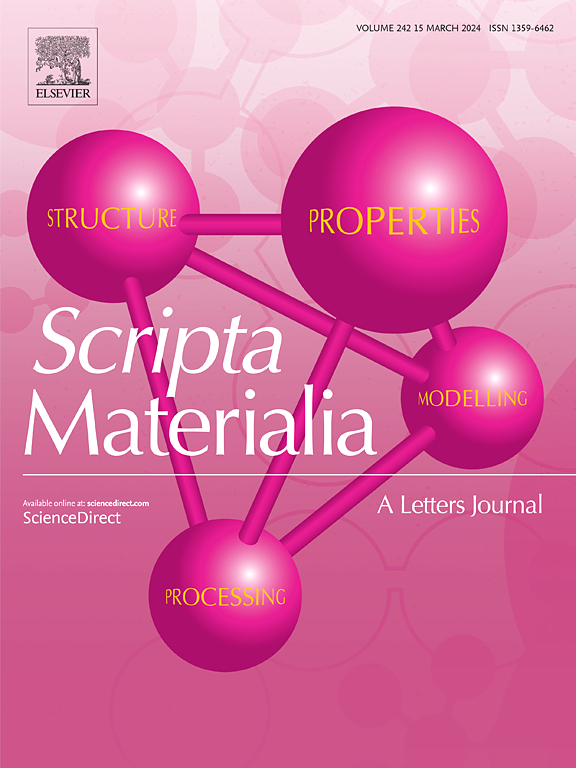Enhanced cavitation erosion resistance of FeCrNiTiAlNb multi-principal element alloy coatings via grain-boundary-phase engineering
IF 5.6
2区 材料科学
Q2 MATERIALS SCIENCE, MULTIDISCIPLINARY
引用次数: 0
Abstract
Cavitation erosion (CE) in hydraulic turbine flow-passing components impedes hydropower efficiency and undermines carbon neutrality efforts. This work presents a grain-boundary-engineered FeCr30Ni25Al5Ti5Nbx multi-principal element alloy coating that achieves breakthrough CE resistance through Nb-mediated microstructure control. The Nb2.6 specimen exhibited 1.35 mg cumulative mass loss after 20 h ultrasonic CE testing, which is 8.9 % of the conventional ZG04Cr13Ni5Mo steel and 17.9 % of the Nb-free counterparts. Microstructural analysis reveals that Nb addition refines BCC grains (24.3 ± 2.4 to 17.7 ± 1.2 μm), increases grain-boundary-decorated FCC phase fraction (up to 24.3 ± 3.5 %), and promotes Laves phase precipitation. These modifications mitigate stress concentration, restrict crack propagation via dislocation pinning, and enable coordinated deformation between BCC and FCC phases. This work establishes a grain-boundary engineering strategy for designing CE-resistant coatings, advancing sustainable hydropower and marine applications.

通过晶界相工程增强FeCrNiTiAlNb多主元素合金涂层的抗空泡侵蚀性能
水轮机流动部件中的空化侵蚀(CE)阻碍了水力发电效率并破坏了碳中和的努力。本研究提出了一种晶界工程的FeCr30Ni25Al5Ti5Nbx多主元素合金涂层,该涂层通过nb介导的显微组织控制实现了突破性的CE抗性。超声CE检测20 h后,Nb2.6试样的累积质量损失为1.35 mg,为常规ZG04Cr13Ni5Mo钢的8.9%,为无nb钢的17.9%。显微组织分析表明,Nb的加入细化了BCC晶粒(24.3±2.4 ~ 17.7±1.2 μm),增加了装饰晶界的FCC相分数(高达24.3±3.5%),促进了Laves相的析出。这些改进减轻了应力集中,通过位错钉住限制裂纹扩展,并实现了BCC和FCC相之间的协调变形。这项工作为设计抗ce涂层建立了一种晶界工程策略,促进了可持续水电和海洋应用。
本文章由计算机程序翻译,如有差异,请以英文原文为准。
求助全文
约1分钟内获得全文
求助全文
来源期刊

Scripta Materialia
工程技术-材料科学:综合
CiteScore
11.40
自引率
5.00%
发文量
581
审稿时长
34 days
期刊介绍:
Scripta Materialia is a LETTERS journal of Acta Materialia, providing a forum for the rapid publication of short communications on the relationship between the structure and the properties of inorganic materials. The emphasis is on originality rather than incremental research. Short reports on the development of materials with novel or substantially improved properties are also welcomed. Emphasis is on either the functional or mechanical behavior of metals, ceramics and semiconductors at all length scales.
 求助内容:
求助内容: 应助结果提醒方式:
应助结果提醒方式:


